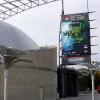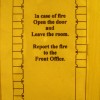Signage
Signage is a functional and communicative element found both inside buildings and along paths of travel that are outside of buildings. They convey information to an intended audience for any given set of circumstance by means of text, graphics, colors, icons, logos, shapes, or other features. Signage also plays an important role in creating an atmosphere that is visually appealing for all those who engage in the environment.
A common form of signage is traffic signage. These types of signs provide information such as speed limits, mile markers, or impeding hazardous conditions that may affect pedestrians or motorists. The size of the sign depends on the speed at which the expected audience will be traveling. Signage that conveys information to a fast moving population will also focus on legibility.
Other types of signs we use today include the plaque, dimensional letter, panel, post and panel/pylon, illuminated panel, non-illuminated panel, photo-luminescent, electronic message and floating signage. Plaques, in particular, are a unique type of signage that can be used to distinguish a particular monument or object that has been dedicated as a memorial or historical site. Other types of signage are used in a variety of locations.
In buildings, signage is used on both the interior and exterior. Interior signage provides way-finding, room identification, direction, orientation and life safety information. These types of signs should comply with local building code requirements. Exterior building signage identifies the name of a building or street address; these signs also advertise or promote a business or service. Businesses and corporations typically use logos on their signage, which are are icons or symbols that are easily recognized. In addition to the building code requirements, these types of signs should meet zoning ordinances as defined by cities and communities. Signage can be installed in a number of different ways depending on the building code or zoning requirements, size and type of sign, and on the information that wants to be conveyed. They can be surface mounted on the face of buildings, projected from an exterior wall, hung from ceiling structures, secured to an interior wall, supported by poles, or installed in any number of different ways.
Signage, depending on the type of project, must meet the needs of the visually impaired. The Americans with Disabilities Act (ADA) Accessibility Guidelines for Buildings and Facilities along with the Architectural Barriers Act (ABA) Accessibility Guidelines have explicit requirements for tactile characters, type, style, color contrast, and sign placement. Title III of the ADA provides information on signage requirements for public accommodations and commercial facilities such as hotels and inns, transportation, dining, recreation and education, retail stores, care facilities, and other public facilities. When visual and tactile characters are required, Chapter 7 of the ABA defines the necessary requirements.
A comprehensive, well designed sign directs people to their destinations in a concise and efficient manner without causing confusion. All of the aspects of a sign are important elements that collectively contribute to the clarity of the message. Successful signage provides significant value to businesses and corporations and provides location awareness to users. In addition, signs assist building owners, occupants and visitors with key information regarding the direction to exits during life endangering situations.

Buildipedia Staff
The Buildipedia research and writing staff consists of dozens of experienced professionals from many sectors of the industry, including architects, designers, contractors, and engineers.
Website: buildipedia.com/










